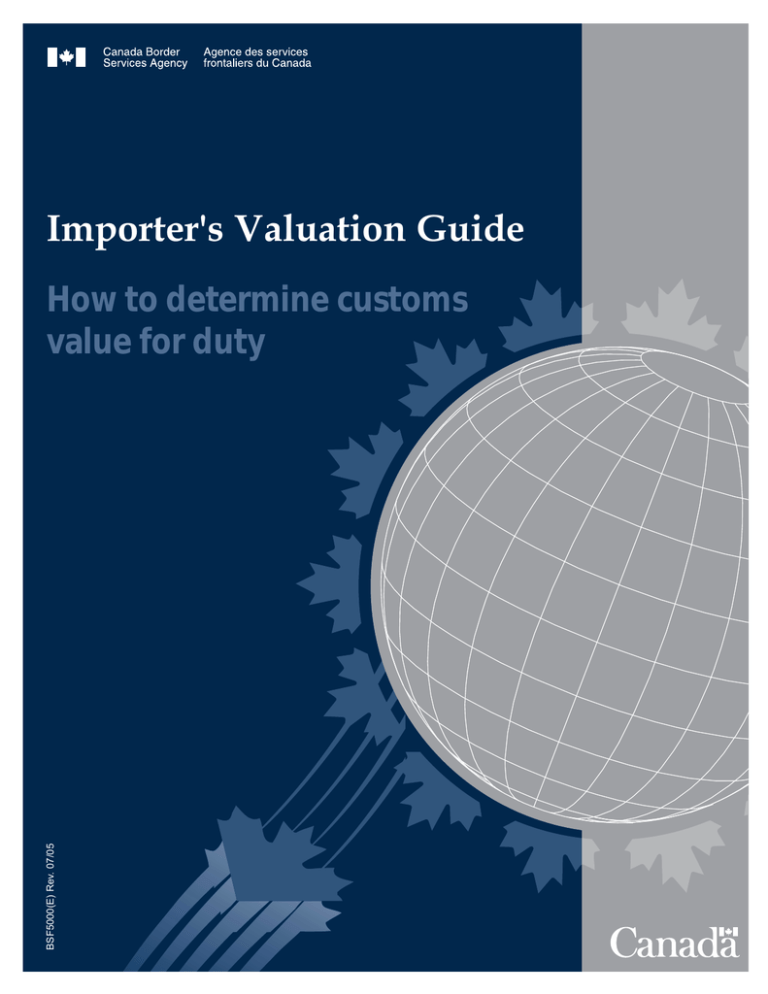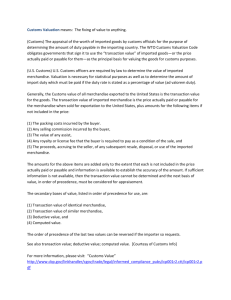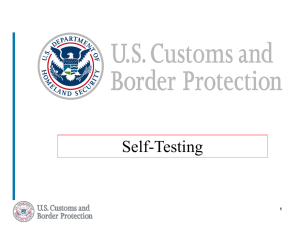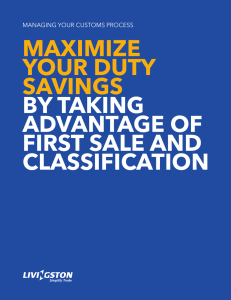Importer's Valuation Guide How to determine customs value for duty /05
advertisement

Importer's Valuation Guide BSF5000(E) Rev. 07/05 How to determine customs value for duty La version française de cette publication est intitulée Guide de l’importateur sur l’établissement de la valeur. Table of Contents Introduction ................................................................................................................................................................. 3 Your Value for Duty Declaration ............................................................................................................................. 3 Methods of Customs Valuation ................................................................................................................................ 4 Transaction value method.................................................................................................................................... 4 Transaction value of identical goods method or transaction value of similar goods method................. 10 Deductive value method ...................................................................................................................................... 11 Computed value method...................................................................................................................................... 12 Residual method .................................................................................................................................................... 13 Value for Duty Codes................................................................................................................................................. 15 Valuation and Related References............................................................................................................................ 16 More Information........................................................................................................................................................ 16 Introduction T his guide gives you basic information on the valuation provisions of the Customs Act, and will help you to: • understand the six methods of customs valuation; and • identify the most appropriate method to value your imported goods. You will find step-by-step instructions in this guide on how to establish value for duty, as well as value for duty calculation templates for each valuation method. You can complete these templates and use them to support your declaration. The templates are provided for your use only and you are not required to keep them with your records. This guide is intended as a basic reference tool to help you determine the value for duty of imported goods. Please note that it does not replace legislation in the Customs Act or the regulations, policy and procedures in the Canada Border Services Agency's (CBSA) D Memoranda series of publications. Some of the D Memoranda series publications are referred to in this guide. The complete D memoranda series is available on the CBSA Web site at www.cbsa.gc.ca/publications. You can obtain printed copies of individual memoranda (for a fee) by calling toll free 1-800-635-7943 or by contacting your regional CBSA Client Services office. Please refer to the section “More Information” for contact information. Your Value for Duty Declaration C anada and most of her trading partners value imported goods based on the rules included in the World Trade Organization's Valuation Agreement, which is also referred to as the Customs Valuation Code. This code establishes a fair, uniform and neutral system for valuing goods in accordance with commercial reality, and prohibits the use of arbitrary or fictitious customs values. Its goal is to ensure that the customs value of all goods entering all countries is established using the same rules, and that the valuation of goods is not a barrier to trade. A value for duty must be declared for all goods imported to Canada. Regardless of the circumstances of your importation, you must establish a value for duty, also referred to as a customs value, according to the valuation provisions of the Customs Act. There are six valuation methods: • transaction value • transaction value of identical goods • transaction value of similar goods • deductive value • computed value • residual 3 You have to use the first of the six methods, the transaction value method, whenever possible to determine the customs value of imported goods. If you cannot establish the value for duty of your imported goods using this first method, you must consider the alternative methods to identify the method that is appropriate. You have to consider the methods in sequence. However, you can reverse the order of application of the deductive and computed methods if you ask your regional CBSA Client Services Office, in writing, before you account for your goods. Memoranda in the D13 series specifically address customs valuation. For more information about the individual valuation methods, see Memorandum D13-3-1, Methods of Determining Value for Duty. You have to keep complete records in support of your value for duty declaration. If we ask for this information, you must make it available for our review - see Memorandum D17-1-21, Maintenance of Records and Books in Canada by Importers. Paragraph 152(3)(d) of the Customs Act states that the burden of proof in any question relating to compliance with the provisions of the act, lies with the person who is party to the proceeding, and not with the Crown. Documentation can include such items as commercial invoices, agreements, cost allocation schedules, proof of payment, or other data that will support your value for duty declaration and calculations. For information on the role of importers and the keeping of records, see Memorandum D13-2-1, Responsibility of Importers and/or Authorized Agents with Respect to Valuation. You have to declare the value for duty of all goods you import to Canada in Canadian currency. Values expressed in a foreign currency must be multiplied by the exchange rate in effect on the date that the goods began their direct and uninterrupted journey to Canada (see Memorandum D13-2-3, Exchange Rate for Calculation of Value for Duty Under the Customs Act). You can access the exchange rates for foreign currency online at www.cbsa.gc.ca or by contacting the CBSA's Border Information Service (BIS) at 1-800-461-9999. Methods of Customs Valuation Transaction value method The transaction value method is the primary method of valuation. It applies where goods are sold for export to Canada to a purchaser in Canada. Under this method, value for duty is based on the price paid or payable for imported goods with consideration to certain adjustments. Your answers to the following questions will help you determine if you should use the transaction value method to value your imported goods. 4 1. Has a sale occurred? ❑ Yes ❑ No You must determine if your goods were imported to Canada as a result of a sale. A sale requires a transfer of ownership of goods for a monetary amount (a price). While not an exhaustive list, examples of situations that would not be considered a sale for export to Canada are: • • • • • goods imported on consignment leased goods barter transactions trade-ins goods invoiced at no charge 2. Was there a sale for export to Canada? ❑ Yes ❑ No The goods must have been imported to Canada as the result of a sale agreement between the purchaser and the vendor. See Memorandum D13-4-2, Customs Valuation: Sold for Export to Canada (Customs Act, Section 48). 3. Was the sale for export to Canada to a purchaser in Canada? ❑ Yes ❑ No To be considered a purchaser in Canada, you have to meet the criteria specified in Section 2.1 of the Valuation for Duty Regulations. For more information, see Memorandum D13-1-1, Valuation for Duty Regulations, and Memorandum D13-1-3, Customs Valuation: Purchaser in Canada Regulations (Customs Act, Section 48). 4. Can you determine the price paid or payable for the goods? ❑ Yes ❑ No Subsection 45(1) of the Customs Act defines price paid or payable as the aggregate of all payments made or to be made, directly or indirectly, in respect of the goods by the purchaser to or for the benefit of the vendor. Defining price paid or payable this way ensures that the sum of all payments a purchaser makes to or for the benefit of a vendor are included in the transaction value, even when the payments are not included in the price shown on the commercial invoice or in the contract for the imported goods. Some items you may have to consider in determining the price paid or payable include: • • • • • • • • • invoice price storage expenses credits for earlier transactions warranty payments settlement of a debt on behalf of the vendor price escalation clauses export duties and taxes quota payments - for more information, see Memorandum D13-3-14, Quota Payments (Customs Act, Section 48 to 53) confirming commissions and credit risk insurance – for more information, see Memorandum D13-4-11, Confirming Commissions and Credit Risk Insurance (Customs Act, Section 48) All discounts that are taken before importation should be considered when determining the price paid or payable. A cash or prompt payment discount taken after importation can also be considered when determining the price paid or payable. For more information, see Memorandum D13-4-10, Discounts (Customs Act, Section 48). For more information, see Memorandum D13-4-3, Customs Valuation: Price Paid or Payable (Customs Act, Section 48). 5 If you answered yes to all of these questions, you meet the principal requirements for using the transaction value method. Please continue to Question 5. If you answered no to any of these questions, you cannot use the transaction value method. You now have to consider the transaction value of identical goods method. 5. Are there any restrictions on the disposal or use of the goods imposed on the purchaser? ❑ Yes ❑ No ❑ Yes ❑ No You do not have to consider the following restrictions when responding to this question: • • • restrictions imposed by law geographical restrictions restrictions that do not substantially affect the price 6. Is the sale or price of the goods being imported subject to any conditions or considerations for which a value cannot be determined? Generally, you cannot use the transaction value method if the sale or price is subject to a condition or consideration for which you cannot determine a value. If your answer to question 5 or 6 is yes, the transaction value method may not be appropriate. Consider instead the transaction value of identical goods method. The individual limitations are described at length in Memorandum D13-4-4, Limitations on the Use of the Transaction Value (Customs Act, Section 48). If you answered no to both questions, please continue to Question 7. 7. Does the purchaser have to pay the vendor any proceeds as a result of a subsequent resale, disposal or use of the goods? ❑ Yes ❑ No If your answer is yes, then the amount identified must be included in, or added to, the price paid or payable. If your answer is yes, but the amount is not known, the transaction value method may not be appropriate. However, before identifying an alternative valuation method, you should consult with your regional CBSA Client Services office. If your answer is no, please continue to Question 8. 6 8. Are the purchaser and vendor related? ❑ Yes ❑ No Subsection 45(3) of the Customs Act provides a definition of “related persons”. For more information, see Memorandum D13-3-2, Related Persons (Customs Act, Sections 45 to 53). If your answer is yes, the transaction value method may still be used if the relationship has not affected the price of the goods. For more information, see Memorandum D13-4-5, Transaction Value Method for Related Persons (Customs Act, Section 48). If your answer is no, or if the relationship has not affected the price of the goods, you next consider if any of the adjustments to the price identified in subsection 48(5) of the Customs Act have to be made. Please continue to Question 9. 9. Are there additions to be made to the price paid or payable for the goods? ❑ Yes ❑ No Paragraph 48(5)(a) of the Customs Act requires that amounts for certain charges and the value of certain goods and services, if not already included in the price paid or payable for the imported goods, must be added to the price paid or payable. These charges and values are identified in Memorandum D13-4-7, Adjustments to the Price Paid or Payable (Customs Act, Section 48) and can include amounts for the following: • • • • • • commissions and brokerage - see Memorandum D13-4-12, Commissions and Brokerage (Customs Act, Section 48) packing costs assists - see Memorandum D13-4-8, Assists (Customs Act, Section 48) royalties and licence fees - see Memorandum D13-4-9, Royalties and Licence Fees (Customs Act, Section 48) subsequent proceeds (a financial advantage to the vendor resulting from resale, disposal or use of imported goods by the purchaser) transportation costs and insurance costs to the place of direct shipment to Canada - see Memoranda D13-3-3, Transportation and Associated Costs (Customs Act, Sections 48 to 54), and D13-3-4, Place of Direct Shipment (Customs Act, Sections 48 to 54). In the event that one of these additions to price paid or payable must be made, but the amount of the addition cannot be identified, value for duty cannot be calculated under the transaction value method. You should consult with your regional CBSA Client Services office before identifying an alternative valuation methodology. If your answer is yes, and the amount of the addition(s) can be identified, calculate value for duty in accordance with the transaction value method template provided. If your answer is yes, and the amount of the addition(s) can be identified, and one (or more) of the deductions from the price paid or payable identified in paragraph 48(5)(b) of the Customs Act can be made, calculate value for duty in accordance with the transaction value method template provided. If your answer is no, please continue to Question 10. 7 10. Are there deductions to be made from the price paid or payable for the goods? ❑ Yes ❑ No Paragraph 48(5)(b) of the Customs Act requires that some charges, if included in the price paid or payable for the imported goods, must be deducted from the price paid or payable. These deductions are also identified in Memorandum D13-4-7, Adjustments to the Price Paid or Payable (Customs Act, Section 48), and include actual charges for the following items: • • • cost of transportation from the place of direct shipment costs arising after the goods have been imported such as construction, erection, maintenance and technical assistance import duties and taxes Note: You can only make deductions for these items if you know the actual amount of the charges incurred or the actual amount of duties and taxes paid as a result of importing the goods. You cannot deduct estimated amounts. Import duties and taxes include those levied under the Customs Tariff, Excise Tax Act, Excise Act, Special Import Measures Act, and any other law related to customs. For more information on eligible deductions from the price paid or payable, please see the following memoranda: • • D13-3-3, Transportation and Associated Costs (Customs Act, Sections 48 to 54) D13-3-4, Place of Direct Shipment (Customs Act, Sections 48 to 54) If your answer is either yes or no, calculate value for duty in accordance with the transaction value method template provided, with consideration to any deduction from the price paid or payable that can be made. Note: Under the transaction value method, value for duty cannot be amended to reflect a reduction in the price of goods after they have been imported, except where a cash or prompt payment discount was negotiated and the purchaser only takes advantage of the discount following the importation of the goods. Two examples of a price reduction after importation that would not result in an amendment to value for duty follow. Price reduction - Example 1 A Canadian entity purchases and imports some goods. Later, the foreign vendor reduces the price to improve the purchaser's competitiveness in the Canadian market. The purchaser cannot adjust the price paid or payable for the goods by the amount of the reduction. Price reduction - Example 2 A foreign vendor retroactively discounts the price of goods already bought and imported to Canada when a Canadian entity makes a second purchase. The importer cannot adjust the price paid or payable of the goods already imported to allow for the retroactive discount. The condition of the discount must have been met before the goods were imported. For more information on price paid or payable and discounts, see Memorandum D13-4-10, Discounts (Customs Act, Section 48). 8 Transaction value method: Value for duty calculation template Calculate value for duty as follows: A. Price paid or payable for the goods (including all direct and indirect payments) (A) __________ (B) __________ (C) __________ (D) __________ B. Additions, if any apply, and if not included in (A) above 1. commissions (except buying agent fees) _______ 2. packing costs and charges _______ 3. apportioned value of assists _______ 4. royalties and licence fees _______ 5. subsequent proceeds _______ 6. transportation and associated costs, and insurance costs to the place of direct shipment _______ Total additions (add lines 1-6) C. Deductions, if any apply, and if included in (A) above 1. transportation and associated costs, and insurance costs from the place of direct shipment _______ 2. amounts for construction, erection, assembly, maintenance or technical assistance after importation _______ 3. import duties and taxes _______ Total deductions (add lines 1-3) D. Value for duty (A + B - C) 9 Transaction value of identical goods method or transaction value of similar goods method Have you considered using the transaction value method outlined in section 48 of the Customs Act? ❑ Yes ❑ No If your answer is yes, please continue. If your answer is no, please review the transaction value method. The transaction value of identical goods method and the transaction value of similar goods method are both described in this section because they are applied in the same way. The difference between the two methods lies in the definitions of “identical” and “similar”. The identical goods method must be considered before the similar goods method, and only if the transaction value method does not apply. Identical goods - Section 49 of the Customs Act Under the transaction value of identical goods method, you calculate the value for duty of the goods you are importing based on the value for duty of other identical goods that were imported to Canada at the same or substantially the same time, and accounted for under the transaction value method. “Identical goods” are defined in subsection 45(1) of the Customs Act and include goods that are the same in all respects, produced by or on behalf of the same person, and in the same country as the goods being appraised. You can adjust the customs value of the other identical goods to allow for differences in trade level, quantity, and transportation costs with the goods being valued. The resulting adjusted customs value of the identical goods is an acceptable value for duty for the goods you are importing. Similar goods - Section 50 of the Customs Act You apply the transaction value of similar goods method in the same way as the identical goods method outlined above. However, the value for duty of the goods you are importing is based on the customs value of other similar goods. “Similar goods” are defined in subsection 45(1) of the Customs Act and include goods that closely resemble and are capable of performing the same functions, and that are produced by or on behalf of the same person, and in the same country as the goods being appraised. You can adjust the customs value of other similar goods to allow for differences in trade level, quantity and transportation costs with the goods being valued. The resulting adjusted customs value of the similar goods is an acceptable value for duty of the goods you are importing. It may be difficult for you to establish the value for duty of your imported goods under either the transaction value of identical or similar goods methods. Data in support of your declaration may only be available from other importers of identical or similar goods. For more information, see Memorandum D13-5-1, Application of Sections 49 and 50 of the Customs Act. You can also consult your regional CBSA Client Services office before you use either the transaction value of identical goods method or the transaction value of similar goods method to establish the value for duty of your goods. 10 Transaction value of identical or similar goods methods: Value for duty calculation template Using either the transaction value of identical or similar goods method, make all your calculations on the basis of sufficient, objective and quantifiable information that establishes the accuracy of the transaction value or the adjustments for differences. Calculate value for duty as follows: A. Transaction value of identical or similar goods (as determined under section 48 of the Customs Act) (A) __________ (B) __________ (C) __________ B. Adjustments to (A), if any apply, to take into account: 1. quantity differences _______ 2. trade level differences _______ 3. differences in the costs of transportation to the place of direct shipment due to mode of transport and/or distance _______ Total adjustments (add lines 1-3) C. Value for duty (A + B) Deductive value method Do any of the methods of valuation outlined in sections 48 to 50 of the Customs Act apply? ❑ Yes ❑ No If your answer is yes, please review the previous valuation methods to determine which method is appropriate. If your answer is no, the deductive value method is the next method to consider. (However, you can reverse the order of application of the deductive and computed methods if you ask your regional CBSA Client Services office, in writing, before you account for your goods.) Under the deductive value method, the value for duty is based on the importer's most common selling price per unit of the goods to Canadian customers (to persons at the first level of trade after importation). You can deduct from the most common selling price an amount that represents the commissions, or the profit and general expenses incurred in selling the goods in Canada. 11 You can also deduct amounts for transportation costs from the place of direct shipment to Canada, Canadian duties and taxes and the costs of assembly, packaging or further processing of the goods in Canada. Costs in Canada for warehousing, distribution and delivery can also be deducted if not already included in the deduction for profit and general expenses. For additional information on the deductive value method, see memoranda D13-7-1, Determination of the Price Per Unit (Customs Act, Section 51), and D13-7-3, Deductions from the Price Per Unit (Customs Act, Section 51). Before you use the deductive value method, you can consult with your regional CBSA Client Services office. Deductive value method: Value for duty calculation template Calculate value for duty as follows: A. Price per unit (A) __________ B. Deductions 1. commissions or _______ 2. profit and general expenses and (if not already included in (1) or (2) above) _______ 3. transportation costs from the place of direct shipment _______ 4. duties and taxes in Canada _______ 5. costs (after importation) of assembly, packaging or further processing _______ Total deductions (add line 1 or 2 to lines 3-5) C. Value for duty (A - B) (B) __________ (C) __________ Computed value method Do any of the methods of valuation outlined in sections 48 to 51 of the Customs Act apply? ❑ Yes ❑ No If your answer is yes, please review the previous valuation methods to determine which method is appropriate. If your answer is no, the computed value method is the next method to consider (unless you have already asked to use this method before the deductive value method). The computed value is the cost of producing the imported goods, plus an amount for normal profit and general expenses, that a firm in the exporting country would incur when selling the same type of goods to Canadian customers, plus an amount for any assists that are not reflected in a producer's costs. 12 To use the computed value method, you must have detailed knowledge of the costs of producing the imported goods. Due to the confidential nature of such information, this valuation method is generally only used by an importer who is related to a vendor who is also the manufacturer of the goods. For more information, see Memorandum D13-8-1, Computed Value Method (Customs Act, Section 52). Before you use this method, you can consult with your regional CBSA Client Services office. Computed value method: Value for duty calculation template Calculate value for duty as follows: A. Amounts for 1. materials employed in production _______ 2. production and processing costs _______ 3. packing costs _______ 4. costs, charges and expenses incurred by the producer for engineering and development work, art work, design work, plans or sketches undertaken in Canada _______ Total amount (add lines 1-4) (A) __________ B. Amount for profit and general expenses (Total amount (A) x profit and general expenses percentage) (B) __________ C. Amount for value of assists (C) __________ D. Value for duty (A + B + C) (D) __________ Residual method Do any of the methods outlined in sections 48 to 52 of the Customs Act apply? ❑ Yes ❑ No If your answer is yes, please review the previous valuation methods to determine which method is appropriate. If your answer is no, the residual method is the next method to consider. If you cannot value your imported goods under the transaction value method or the four subsequent methods, you must use the residual method of valuation. 13 The residual method does not identify specific requirements for determining value for duty. Rather, you reconsider the requirements of the first five methods in sequence and then flexibly apply the method that requires the least amount of adjustment using information that is available in Canada. The value for duty you establish using the residual method must be fair and reasonable, and should reflect commercial reality. Memorandum D13-9-1, Residual Basis of Appraisal Method (Customs Act, Section 53), provides examples of how the residual method might be applied. If you find that you must resort to the residual method, you can consult your regional CBSA Client Services office for guidance. Prohibited methods Value for duty cannot be established under the residual method using the following approaches: • the selling price in Canada of goods produced in Canada; • the price of goods on the domestic market of the country of exportation; • the cost of production, other than a computed value that has been determined for identical or similar goods under section 52 of the Customs Act; • the price of the goods for export to a country other than Canada; • arbitrary or fictitious values. Value for duty calculation • Review the information in the alternative valuation methods provided in this guide. • Flexibly apply the method that requires the least amount of adjustment using information that is available in Canada. • Consider each of the elements of value for duty identified in the relevant calculation template. 14 Value for Duty Codes W hen you complete Form B3, Canada Customs Coding Form, to account for goods imported to Canada, you must declare a value for duty code in field 31 of each transaction line you complete on the form. You can download and print a copy of Form B3 from the CBSA Web site at: www.cbsa.gc.ca/publications. Additional information about Form B3 coding is available in Memorandum D17-1-10, Coding of Customs Accounting Documents. The code consists of two digits: • the first digit shows the relationship between the vendor and the purchaser; and • the second digit shows the valuation method used. First digit (relationship between the vendor and the purchaser) 1. The vendor and the purchaser are not related as defined in subsection 45(3) of the Customs Act. 2. The vendor and the purchaser are related as defined in subsection 45(3) of the Customs Act. Second digit (valuation method used) 3. Price paid or payable without adjustments (section 48 of the Customs Act) 4. Price paid or payable with adjustments* (section 48 of the Customs Act) 5. Transaction value of identical goods (section 49 of the Customs Act) 6. Transaction value of similar goods (section 50 of the Customs Act) 7. Deductive value of imported goods (section 51 of the Customs Act) 8. Computed value (section 52 of the Customs Act) 9. Residual method of valuation (section 53 of the Customs Act) Example The vendor and purchaser are related, and the value for duty is the price paid or payable with adjustments made under paragraphs 48(5)(a) and (b) of the Customs Act. The importer must declare value for duty code 24. * For information on adjustments to price paid or payable, review the transaction value method. 15 Valuation and Related References T he complete D Memoranda series is available on the CBSA Web site at:www.cbsa.gc.ca/publications. You can also obtain printed copies (for a fee) by: • calling toll free 1-800-635-7943 • visiting your regional CBSA Client Services office (see the “More Information” section) The following memoranda provide information on specific valuation challenges when determining the value for duty of certain categories of goods. • D13-10-1, Used Goods (Customs Act, Sections 48 to 53) • D13-10-2, Used Automobiles, Motor Vehicles, and Other Vessels (Customs Act, Sections 48 to 53) • D13-11-1, Goods Sold in Canada While Entered Temporarily for Conventions and Exhibitions • D13-11-2, Value for Duty of Certain Information-Based Products (Customs Act, Sections 48 to 53) • D13-11-3, Value for Duty of Printed or Lithographed Matter of Paper • D13-11-4, Value for Duty of Promotional Material • D13-11-6, Determining Value for Duty of Computer Software If you have any reason to believe that the value for duty you declared is not correct, an adjustment to value for duty may be necessary. For more information, see Memorandum D11-6-6, Self-Adjustments to Declarations of Origin, Tariff Classification, Value for Duty and Diversion of Goods. Other useful Web pages CBSA publications and forms including technical publications (e.g., D Memoranda, Customs Notices) www.cbsa.gc.ca/publications Importing - A Step-by-Step Guide (small- and medium-sized enterprises) www.cbsa.gc.ca/sme Canadian International Trade Tribunal www.citt.gc.ca World Trade Organization www.wto.org World Customs Organization www.wcoomd.org More Information A dditional information on customs valuation is available from the Border Information Service (BIS) automated system at 1-800-461-9999 toll-free from anywhere in Canada. If you're calling from outside Canada, call (204) 983-3500 or (506) 636-5064 (long-distance charges apply). Contact your regional CBSA Client Services office. A list of these offices as well as information relevant to all importers but tailored for small- and medium-sized importers can be viewed at www.cbsa.gc.ca/sme. 16




